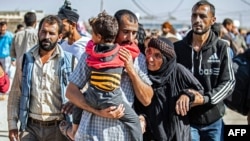An effort to reduce growing strains on overcrowded prisons in Syria, some holding thousands of captured Islamic State fighters, is being met with cautious optimism in Washington, even though it involves letting hundreds of the terror group’s adherents walk free.
The plan put into motion last week by the Kurdish-led Syrian Democratic Council (SDC), the political arm of the U.S.-backed Syrian Democratic Forces (SDF), calls for the release of so-called “low-level” Islamic State members under a general amnesty.
Already, 631 such Syrian nationals have been freed, allowed to return to their homes, while another 253 have seen their sentences cut in half, and Kurdish officials say more releases are expected in the coming months.
So far, the United States is on board.
“We see these return and reintegration initiatives as positive,” a State Department spokesperson told VOA, noting the release “focused on nonviolent offenders who are not assessed to pose a radicalization risk to their communities.”
The official, speaking on the condition of anonymity given the sensitivity of the matter, also suggested aid could be available to help the process go smoothly.
“We, along with our coalition partners, are prepared to support receiving communities as part of ongoing stabilization initiatives,” the spokesperson said.
Concerns about what to do with captured IS fighters and IS supporters have only grown since the collapse of the terror group’s caliphate in March 2019.
Within months, key Pentagon officials were warning that the more than a dozen makeshift prisons set up by the SDF to hold, at the time, more than 10,000 captured IS fighters, including 2,000 foreign fighters, were simply not sustainable.
Since then, the warnings have only grown louder, sparked by a series of riots starting this past March.
By late June, the U.S.-led anti-IS coalition told the Pentagon’s Inspector General the overcrowded prisons were contributing to “an enduring and ever-increasing risk to mission,” and that “the risk of a mass breakout cannot be discounted.”
At the same time, repeated calls by the U.S. for other countries to relieve the burden on the SDF by repatriating their foreign fighters have largely gone unheeded.
And despite millions of dollars in aid from the U.S. to help repair and secure the prisons, officials with the SDF and SDC voiced concern it would not be enough, arguing the prison population had grown to almost 20,000 inmates, including about 12,000 Syrian nationals who had sided with IS.
The State Department spokesperson told VOA the U.S. believes releasing the low-level IS prisoners will help reduce overcrowding at the SDF-run prisons, “which provides humanitarian benefits and improves internal security.”
The spokesman also expressed confidence in the SDF, pointing out this is not the first time IS prisoners have been released.
“The SDF and civilian authorities have managed these programs responsibly, and we expect that they will continue to do so,” the official said.
In a statement last week, SDC co-chair Amina Omar sought to play down concerns, arguing the prisoners who were released included those “convicted of terror charges whose hands are not stained with the blood of Syrians.”
Not everyone is as optimistic, though.
“ISIS likely recruited aggressively within detention centers due to the SDF’s failure to isolate radical elements of the population,” Eva Kahan, a researcher at the Washington-based Institute for the Study of War, told VOA, using an acronym for the terror group.
“This initial release will supply tens to low hundreds of potential ISIS fighters or supporters to active insurgent cells in the Middle Euphrates River Valley and could add fuel to that insurgency’s flames,” Kahan said.
Other experts who have studied the region, while not ready to rule out possible blowback, argue the success or failure of the prisoner releases may hinge more on what happens next.
“Much is going to depend on the conditions that they encounter back in their communities and whether or not conditions are conducive to their reintegration,” said Mona Yacoubian, a senior adviser at the Washington-based U.S. Institute of Peace.
“The extent to which people are released into conditions that are the kinds of conditions that feed the grievances that often can lead to recruitment into groups like ISIS, it's certainly a concern,” she said. “There's no 100% certainty on this.”









